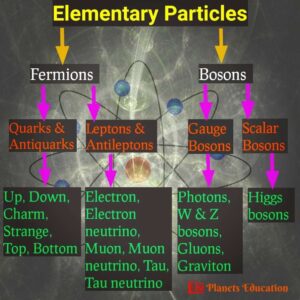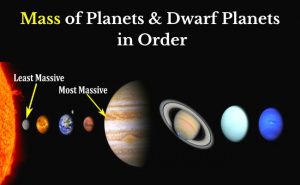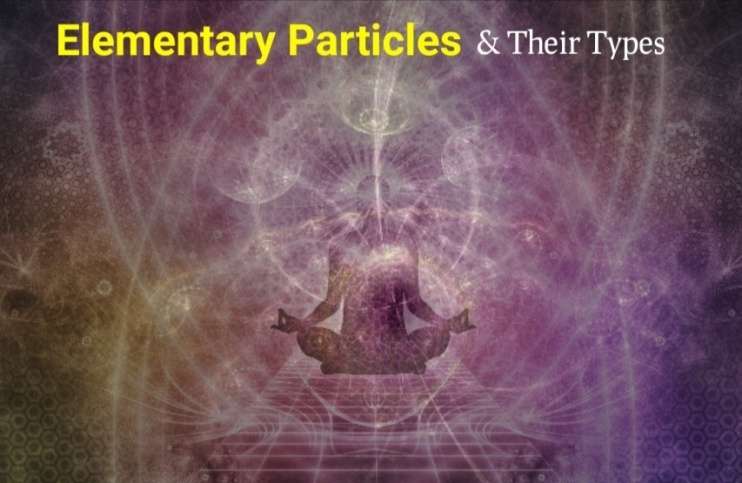Elementary particles are also called fundamental particles and have no other smaller particles within them. These particles generate every matter in the universe though not composed of any other particles.
- Elementary particles are “matter particles”, “antimatter particles”, and “force particles”.
Fundamental fermions are ‘matter and antimatter particles’ and fundamental bosons are known as the force particles.
The matter and antimatter fundamental particles give shape to all physical objects in the universe. Whereas the force particles are responsible for the fundamental forces in the universe and create interaction between matter particles.
As we know matter and other physical objects are made of atoms. Once atoms were considered fundamental particles but further studies in the field of physics showed that ‘electron’, ‘proton’, and ‘neutron’ are the smallest particles.
Recent studies by physicists suggest that protons and neutrons are also not the smallest particles and they are made of elementary particles like quarks. All physical objects in the universe are composed of fermions and bosons.
- (Read about:- who invented infinity)
Types of Elementary particles
There are mainly two types of elementary particles; Fermions and Bosons.
According to the standard model of particle physics, these particles are also divided into further subatomic particles:
1. Fermions
- Quarks and antiquarks (up, down, charm, strange, top, bottom)
- Leptons and antileptons (electron, electron neutrino, muon, muon neutrino, tau, tau neutrino)
2. Bosons
- Gauge bosons (photon, W and Z bosons, gluons, graviton)
- Scalar bosons (Higgs boson)
According to the standard model of particle physics, there are 12 elementary fermions and these fermions also have corresponding antiparticles. So, the total number of elementary particles is 24 elementary fermions plus elementary bosons like gauge bosons and Higgs bosons.
- (Also read about – Higgs boson or God particle)

List of elementary particles
A list of the elementary particles with their corresponding antiparticles and elementary bosons is given below:
- Up quark (u)
- Up antiquark
- Down quark (d)
- Down antiquark
- Charm quark (c)
- Charm antiquark
- Strange quark (s)
- Strange antiquark
- Top quark (t)
- Top antiquark
- Bottom quark (b)
- Bottom antiquark
- Electron
- positron (antielectron)
- Electron neutrino
- Electron antineutrino
- Muon
- Antimuon
- Muon neutrino
- Muon antineutrino
- Tau
- Antitau
- Tau neutrino
- Tau antineutrino
- Gluons
- Photons
- W and Z bosons
- Graviton (hypothetical)
- Higgs boson
Quarks
Quarks are elementary particles and it combines to form composite particles called hadrons. These quarks and antiquarks have never been detected in isolation. They only got detected in hadrons as composite particles.
Baryons (a combination of three quarks: protons and neutrons) and mesons (one quark and one antiquark) are types of hadrons.
Protons (two up quarks and one down quark) and neutrons (two down quarks and one up quark) are the hadrons, made of two or more quarks.
Properties of the quarks
- Quarks have the following intrinsic properties like an electric charge, color charge, mass, and spin.
- These are the only elementary particles that experience all 4 fundamental forces (electromagnetism, gravitation, strong interaction, and weak interaction).
- There are six types of quarks, known as flavors of quarks (up, down, charm, strange, top, bottom) and their corresponding antiquarks.
- Antiquarks have the same properties as quarks except they have an opposite electric charge but the same magnitude.
- Up and down quarks have the lowest mass. They are the most stable and common types of elementary particles in the universe.
- Quarks have the property of color charges, that make them engage with a fundamental force strong interaction. This interaction is a reason to form subatomic composite particles like hadrons.
- Up, charm and top quarks have a charge of +⅔ times of elementary charge (e= 1.6 × 10-19 C). Whereas down, strange, and bottom quarks have elementary charge -⅓ e.
- All known quarks have a spin of ½.
- A quark of one type can transform into a quark of another type by absorbing or emitting a W boson (through a weak interaction).
- Every quark contains three types of color charge, whereas every antiquark contains three types of anticolor charge. According to their combination, they have strong interaction fundamental force.
Leptons
The word leptons come from the Greek word ‘leptos’, which means small or thin. Leptons are elementary particles that have a spin of ½.
There are two types of leptons, 1. Charged leptons (electron, muon, tau) and 2. Neutral leptons (electron neutrino, muon neutrino, tau neutrino).
- Charged leptons are the most common, in which electron is the best-known lepton.
Properties of the leptons
- Leptons have the following intrinsic properties like an electric charge, spin, and mass.
- Leptons do not have the property of color charge and do not participate in strong interaction.
- They experience only three fundamental forces (electromagnetism, gravitation, and weak interaction).
- Electron, muon, and tau has a charge of -1e, whereas neutral leptons do not have any electric charges.
- Antileptons have the same properties as leptons except they have an opposite electric charge with the same magnitude. Neutral leptons do not have electric charges, so according to a theory, these leptons are their own antiparticles.
- Leptons have small masses compared to all other elementary particles.
Bosons
Bosons are the elementary particles with spin-1 (gluons, photons, W and Z bosons) and spin-0 (Higgs bosons). The name ‘boson’ was taken after an Indian physicist Satyendra Nath Bose.
Elementary particles with spin-1 mediate forces, while the Higgs boson exists in the Higgs field and this field creates mass in all elementary particles. Unlike the fermions, bosons can occupy the same quantum states.
- Graviton is a hypothetical elementary particle and according to scientists, it mediates the force of gravity.
There are 5 types of elementary bosons (6 if hypothetical graviton is considered):
- Higgs boson
- Photon
- Gluons
- W boson
- Z boson
- Graviton – is a hypothetical elementary particle. It has spin-2 with a property of force carrier of gravity.
Properties of the bosons
- Fundamental fermions (quarks and leptons) create matter in the universe, whereas fundamental bosons are force carriers. These force carrier bosons hold matter of the universe together while functioning like a ‘glue’.
- If a particle has an integer spin (s= 0, 1, 2,…), it would have the property of bosons and work as a force mediator.
- Higgs bosons are found in the surrounding of the Higgs field. The Higgs field is responsible for mass in every elementary particle. Higgs bosons are called “scalar boson” with a property of spin-0.
- Photons, Gluons, and W & Z bosons are called “vector bosons” and have spin-1.
- Photons are the force carrier for fundamental electromagnetic forces. These particles have a property of wave-particle-duality.
- W & Z elementary bosons are the force carriers and it mediates the weak force.
- Gluons are the force carrier for fundamental strong force between the particles of the quarks. As suggested by its name ‘Gluon’ it acts like a ‘glue’ to stick the quarks particles together.
This was the information about elementary particles. These particles are known as fundamental particles also. You may have got information about types of elementary particles and a list of them.
Must Read:-
- 5 Best Solar System Backpacks in 2024

- Mass of Planets in Order from Lightest to Heaviest

- Star Projector {2024}: Star Night Light Projector


